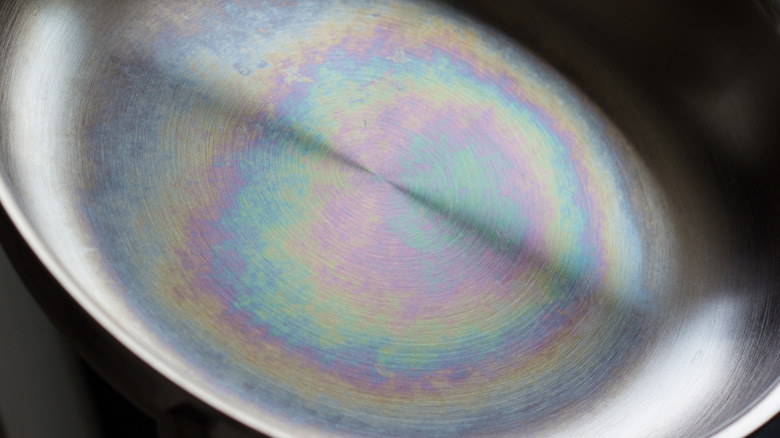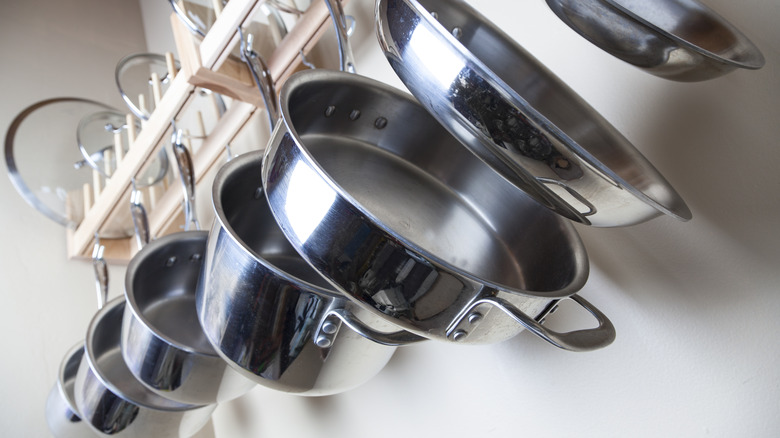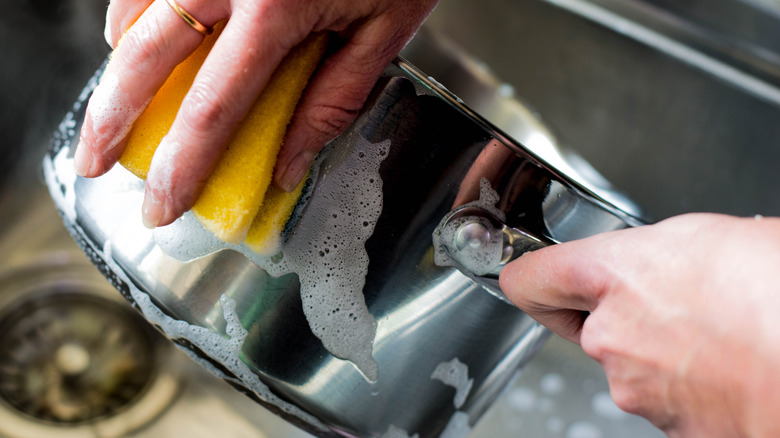Clean Rainbow Stains From Stainless Steel With One Easy Ingredient
Stainless steel cookware is designed to withstand the heat of the kitchen and the test of time. Our favorite pans can even become heirlooms if they're treated with enough care. And yet, even though we follow all the top tips for cooking with stainless steel, we keep ending up with rainbow stains spreading across the surface.
Though they might remind you of the sheen on a soap bubble, the blotches aren't caused by dishwashing residue, burnt food, or anything else left behind — nor do they change the pan's cooking ability. That's right, the shimmer is not a sign of damage, it's just a quirk of the materials that make your pot durable and rust-resistant.
The discoloration (or multi-coloration) is a result of the chromium metal coating on your pan reacting to oxygen and heat. And, just like an oxidized apple, the pan remains safe to use. The stains are also easy to remove with diluted white vinegar. Pour the liquid onto the pan and give it a scrub with a soft sponge or cloth to clear the rainbows away.
Understanding chromium
Chromium is the metal in stainless steel that helps the material live up to its name. Without it, the iron in your pot would fall victim to corrosion as it comes into contact with oxygen, making it unusable. The additive also produces the polished shine we expect in our cooking tools and appliances, and helps harden steel.
But the metal has a weakness. Chlorine and chloride can degrade chromium oxide, the protective outer layer of your pans. For that reason alone, you should never use harsh chlorine bleach or abrasive cleaners to combat staining, as you'll just be hurting your pan.
Another move to preserve your metal: Wait before salting your pasta water. Sodium chloride, aka salt, can also cause your pot to develop pits, which are small, permanent dents, as the crystals interact with the water's oxygen and the chromium. The best approach to cooking with salt is to add it alongside your noodles when the water is at a rolling boil and contains less oxygen. This helps protect against the chemical reaction and ultimately rusting.
Scrubbing off hard water and other discoloration
If you're no longer seeing rainbows and instead have chalky white marks, you probably have hard water. Dissolved minerals like calcium and magnesium can stick to your kitchen tools as you use tap water. If the vinegar rinse hasn't cleaned the stains off, you can test out the parchment paper trick to clean hard water stains and rub your pans with the paper to remove the build-up.
Or you can go back to basics and swap vinegar for baking soda to tackle any and all remaining residues. For scorch and grease marks in particular, it helps to boil a small amount of the powder with water on the stove before gently attacking stains. Or turn to Bar Keepers Friend, a favorite of professional chefs and home cooks alike, to cut through remaining splotches.
Whatever you do, don't use steel wool to finish the job. Metal scrubbers will scratch the smooth metal. And remember to always try washing stainless steel with the gentlest materials (dish soap and water) before moving on to stronger acids and cleaners.



